Picked At Peak Of Perfection
/7 Comments/in Fruit, Gardening, Vegetables/by Lee ReichTomatoes Vs. Sweet Corn
Some gardeners sit tapping their fingers waiting for the first tomato of the season to finally ripen. I don’t. I’m waiting to sink my teeth into my first-picked ear of sweet corn.
Not that my tomatoes don’t taste really good, but they’re also good all winter dried or canned, as is or as sauce. Or just frozen.
An ear of sweet corn, though, captures the essence of summer. Not just for flavor and texture. It’s the whole ritual of peeling back the husks and snapping them off at their bases, brushing away the silk before steaming the ears, and then, holding an ear at each end, biting off kernels from one end to the other like an old fashioned typewriter carriage. (An image perhaps unknown to readers below a certain age.)
An art to harvesting corn at the just-ripe stage, and anxiousness for that first taste, make harvesting, especially early in the season rather tenuous. I do early planning for that first taste by counting the days-to-maturity from when I planted. Problem is that the days listed on seed packets vary: One seed company lists days to maturity for Golden Bantam, the variety I grow, at 75 days; another lists it at 85 days; another at 78 days; and yet another, more realistically, at 70 to 85 days. It depends on where the variety is grown and how the season develops.
The real countdown begins when tassels first appear atop the stalks. Harvest will be about 3 weeks hence.
Then it’s time to keep an eye out for drying tassels at the end of an ear. Once that happens, the time is near. That right moment is critical because harvested too soon, and the kernels have little taste. And this is among those fruits — yes, corn is a fruit, botanically — that will not ripen at all following harvest. Harvested too late, and the kernels are tough and starchy.
That exact right moment for harvest is when the ear feels “full” when grasped in my hand and a kernel on the peeled-back husk, with the ear still attached to the stalk, oozes a milky fluid when pressed with the thumbnail. If all these systems are go, it’s time to snap off the ear and whisk it to the waiting pot of steaming water.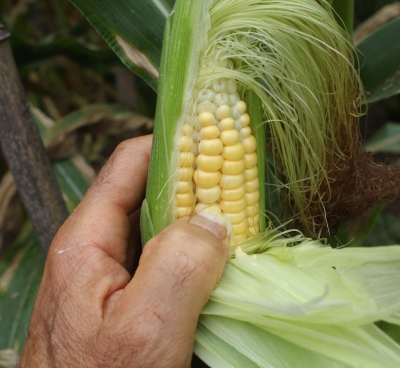
Golden Bantam is a non-hybrid variety. Like other non-hybrids, a planting does not ripen all at once, which is not a good commercial characteristic. It’s fine for me, though, because between staggered plantings and a wide window for harvest for each planting, I intend to be eating Golden Bantam corn, a favorite for many gardeners since its introduction in 1906, for weeks to come.
Watermelon, Are You Ripe
Besides the first harvest of Golden Bantam, which I’ll be enjoying by the time you read this, I’m also eagerly awaiting the first harvest of watermelon, which, according to days-to-maturity listed on the seed packet, 65-75 days, I should have already been eating. (I sowed seeds indoors in pots in mid-May but it’s been a relatively cool growing season.)
While I’m confident in harvesting sweet corn at just the right moment, not so for harvesting watermelon, another fruit that will not ripen at all once harvested. Yes, I know all the published indicators of ripeness: drying up of the tendril closest where the fruit is attached to the vine; a dull thud, rather than a tighter, ringing or hollow sound, when rapped with my knuckles; and a yellow or cream-color of the fruit where it rests against the ground, and a toughening of the skin there, enough to resist indentation with a thumbnail. (The thumbnail is evidently a useful harvest tool.)
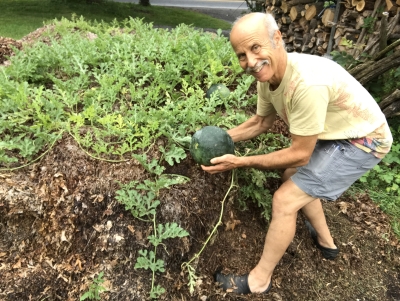
A ripe watermelon?
Still, I’m not confident about harvesting watermelons on time, and not even just the first ones to ripen. The trial and tribulation is worth it. I hope to be harvesting and eating ripe watermelon also by the time you read this. (Update: I did and it was.)
Tomatoes, You Are Ripe
In contrast to harvesting Golden Bantam corn and watermelon (I grow the variety Blacktail Mountain), tomatoes are cinch to harvest. Except for some green-ripe varieties, which I don’t grow, tomatoes turn their characteristic shade of red when ripe.
Tomatoes can even be harvested underripe to ripen off the vine. Research has shown that when a tomato is about half green and half pinkish-red on the vine, a layer of cells form across the stem of the tomato sealing it off from the main vine. Then nothing that can move from the plant into the fruit, so the fruit can ripen to perfection.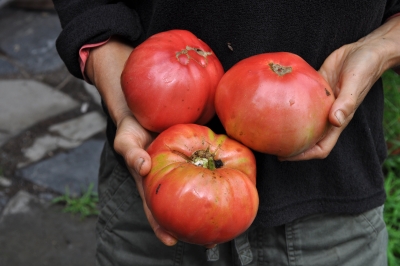
I came across some older research (J. Amer. Hort. Soc. 102:724-731. 1977) showing that the best-tasting tomatoes are those thoroughly vine-ripened. Duh. I knew that, and will harvest only vine-ripened tomatoes.
Making Sense
/1 Comment/in Flowers, Gardening, Planning, Vegetables/by Lee ReichLilies, More Than Just Pretty
I’m triply thankful for the lily stems in the vase in the kitchen.
First, for their beauty. The large, lily-white (of course) petals flare out into trumpets, from whose frilly throats poke groups of rust-red anthers and single tear-capped stigmas. The petals spread about 8 inches wide from one side to the other, and the single stalk I plunked into the vase sports six of them!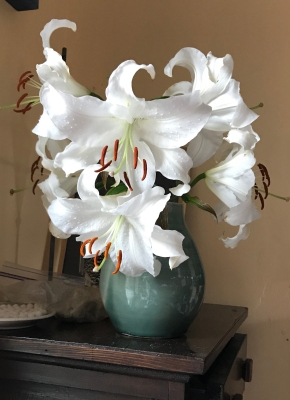
Second, I’m thankful for the lilies’ fragrance. The heady, sweet fragrance fills the whole room.
And third, I’m thankful that the plants, cut from outdoors where they share a bed with staked Sungold tomato plants, are alive. They’ve been threatened by a relatively new pest, the lily leaf beetle (Lilioceris lilii). This European pest made its North American debut in Montreal in 1945, and its debut on my farmden in 2015.
Lily leaf beetle can be controlled by sprays, even organic ones such as Neem or spinosad. But I’m not keen on spraying anything on plants rubbing elbows with edibles, in this case my Sungold tomatoes.
The beetles’ bright red color makes them easy to spot, at which point they can be crushed. Battling the beetle mano a mano is a viable control for a backyard planting. This was my approach a couple years ago. With other garden distractions and many crown imperial (Fritillaria) plants, which also are attacked by the beetle, I abandoned any efforts to control the beetle.
Yes, I saw some beetles on the lilies this season; yes, the plants are still doing well. Plants can tolerate a certain amount of pest damage and still do fine.
Play It Again Sam
My awesome lilies aren’t just any old lilies. They’re true lilies (Lilium species), not daylilies (Hemerocallis species). Once we’ve narrowed down “lily” to the genus Lilium, there are about 100 species within that genus from which to choose.
My lily is one of many varieties of Asiatic hybrid lilies. Its name: Casa Blanca. I highly recommend growing it.
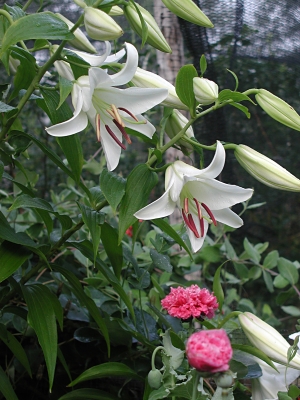
Casablanca lily in the garden
Popeye’s Delight, Later
With eyes and nose taken care of, let’s move on to another of the senses, taste. I’d like some spinach. But I can’t have it — yet. I can plant it very soon, though, and then in a month or so I can be eating it.
So why didn’t I plant it a month ago so I could be eating it now? The reason is that spinach is a long day plant, which flowers (aka “goes to seed”) during summer’s long days. Planted a month ago, even two months ago, and after making a rosette of a few leaves the plant would pump its energy into flowers and seeds. Besides yielding a paltry harvest of leaves, that whole “going to seed” thing also ruins the flavor of the leaves.
Actually, it isn’t long days that make spinach gustatorily morph from Dr. Jekyll to Mr. Hyde; it’s short nights. (Photoperiodism, the name for this response, was originally though to be the response to daylength; calling it a response to “daylength” stuck even after it was discovered that the response was to the length of the the night.) Beets, gladiolas, lettuce, and radishes are also “long day plants.”
Photoperiod doesn’t work alone in prodding plants to grow or flower. Temperature, either before germination or while the plants are growing, also figures in, as does light intensity and soil moisture. Spinach usually flowers when days are 14 or more hours long (more correctly, short nights that are 10 or less hours long), but will also do so following 8 hour days (16 hour nights) if the seeds are chilled.
Nights are now just over 10 hours long so I can plant spinach. While the plants are growing, cooler temperatures, which are coming this way, and adequate water, which my plants will get thanks to drip irrigation, also factor in to keep spinach from going to seed. So the spinach that I sow today will put all its energy into growing large and tasty leaves.
Peas, Please
A taste of peas would also be nice. The spring harvest was good. Still, some gardeners successfully plant peas in summer for an autumn harvest. Not me.
Daylength isn’t what messes up late sown peas, for me, at least. Heat is. Peas languish during hot weather, common through August and even lingering into early autumn. So the peas grow poorly, and if they do weather the hot weather, they are apt to be struck down by the first frost of autumn.
I’ve heard that Wando is a pea variety that can take some heat. I haven’t tried for an autumn harvest for many, many years. With climate change, perhaps autumn peas are worth another try.
Fruit, Again, With Nod To Michael Jackson
/0 Comments/in Fruit, Gardening, Planning, Pruning/by Lee ReichBlackcaps Redux, This Season
I took a cue from Michael Jackson today when pruning my black raspberry (a.k.a. blackcap) plants. Not that I had to prune them today, or even this time of year. But I couldn’t stand looking at the tangled mass of thorny canes. And, more importantly, the tangled mass would make harvest, slated to begin in a couple of weeks or so, a bloody nightmare.
(Most blackcaps bear only once a year, in early summer, so tidiness would be the main reason to prune conventional blackcaps now. Pruning would also let remaining canes bathe in more light and air, reducing the threat of diseases. My blackcap plants, though, are the two varieties — Niwot and Ohio’s Treasure — that bear twice a year; hence, my pruning now to make picking the soon-to-ripen second crop less intimidating.)
All blackcaps have perennial roots and biennial canes. Typically, the canes just grow their first year, flower and fruit their second year, then die. Niwot and Ohio’s Treasure differ in bearing on both one-year-old canes and on new canes. I picked the early summer crop from canes that grew last year. And now my mouth is watering as I look forward to the late summer crop, which will be borne on canes that just started growing this season.
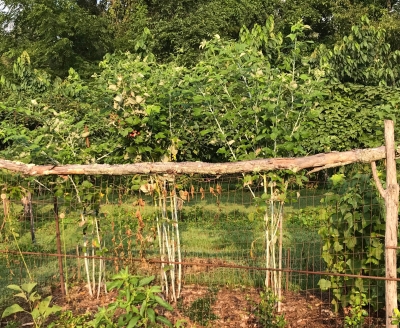
Pruning is straightforward. I started by lopping right to ground level all the canes that bore the early summer crop; they’re dying anyway. Step two is reducing the number of new canes, selectively keeping the fattest and healthiest-looking ones, and lopping all others to ground level. Even then, I reduce their number to the best six of them. That’s it. Easy, as long as the thorns are avoided.
My blackcaps are in a row, three feet apart. An iron pipe sunk into the ground next to each plant provides support for each plant’s clump of stems. With pruning finished, I tied a piece of rope to the pipe and then around the clump of stems, a gloved hand cozying the thorny stems into position while my ungloved hand tied the rope, à la Michael Jackson.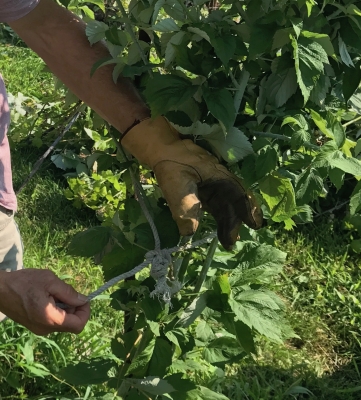
Rotten Plums
I wish that pruning was all that my plum trees needed. With this being such a good year for fruits generally, I was very hopeful for a good crop. And they looked fine up until a week ago, when the fruit started ripening — and rotting.
Brown rot is the culprit, mostly the handiwork of the fungus Monolinia fruticola. Characteristic powdery, gray masses of spores form on the surfaces of rotting fruits, which eventually dry to become “mummies.” Brown rot is not new to me; I’ve experienced it on peaches, nectarines, and plums in the past. It also attacks apricots, cherries, and other “stone fruits” (Prunus genus). Typically, a plant bears well for a couple of years while the fungi are building up, and then full-fledged, annual attacks begin.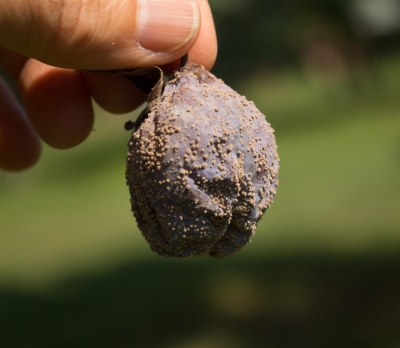
The usual recommendation to hold the fungus at bay is, first, to remove sources of inoculum by cleaning up all infected fruit in summer and mummies in winter, and pruning away dead, infected twigs. That’s quite a job on a big plum tree.
I sprayed my trees with sulfur many times this past spring. Sulfur is an organically approved fungicide, used by gardeners and farmers for thousands of years, that is effective against brown rot. But only for a few days. Hence my repeated sprays, evidently not repeated enough.
The easiest approach would be for me to grow brown rot resistant varieties.
Plumquest Begins
So now I am embarking on a plumquest, my search for plums that taste good and are resistant to brown rot. Resistant genes must lurk somewhere — actually right in my yard, on the wild plums. They hardly ever show fuzzy grayness; they also don’t taste very good.
I now remember a pertinent page I photocopied many years ago. Shuffling through piles of papers on my desk, I come across the page, from a scientific-looking paper, entitled “Range of known genetic traits in Plum cultivars.” That’s a start, and the list on the page includes one of my favorite plums, the Green Gage, also known as Reine Claude Verte, as resistant. Shiro, which I grow with some success, is only listed as “tolerant.”
My next queststep is on the web, bringing me to a publication entitled “The Cultivated Native Plums and Cherries,” authored by Liberty Hyde Bailey in 1892. I immediately ordered a reprint to make it easier to sort through the many varieties and their gustatory and pest potentials.
Once suitable varieties are identified, the next queststep is to locate trees or, more likely, stems for grafting, to bring here to the farmden. I will report on my plumquest as events unfold.

